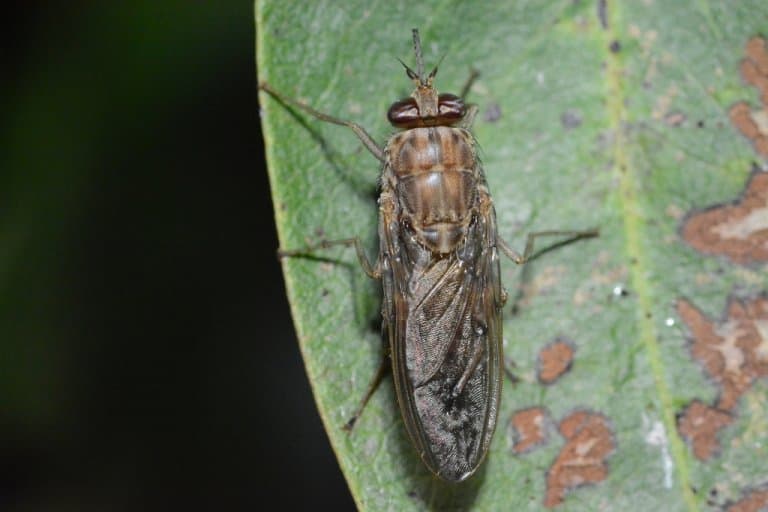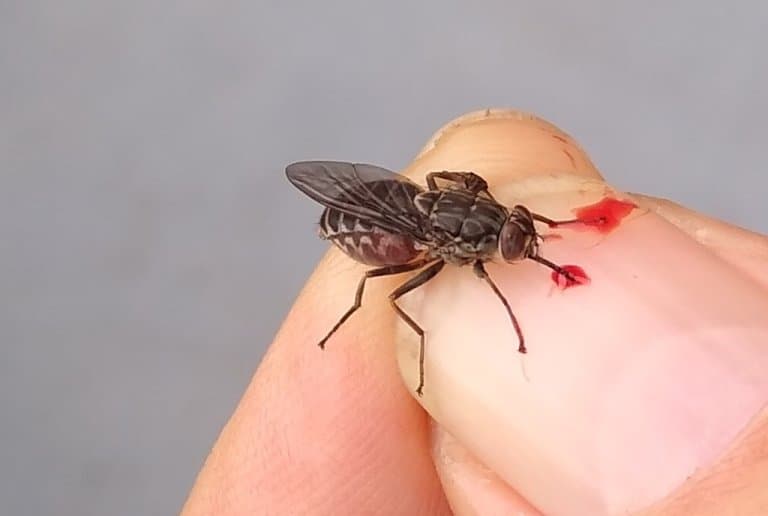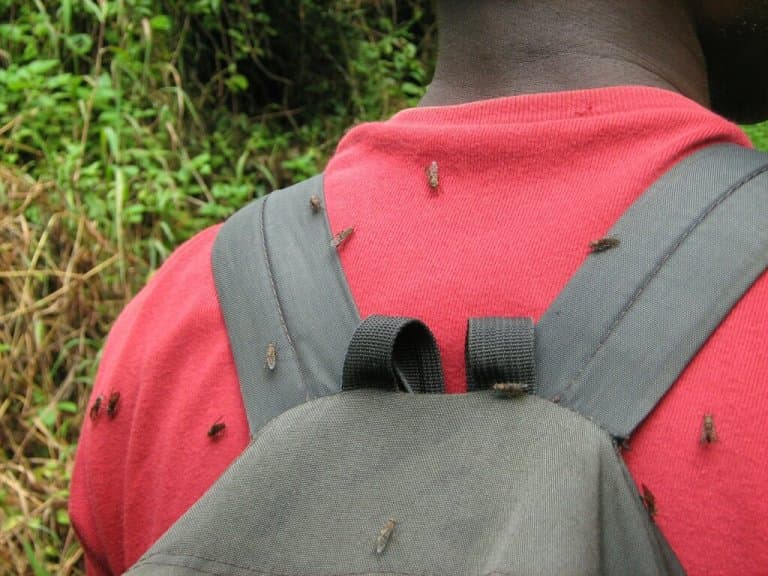Tsetse Fly Profile
Flies can be very useful. The Drosophila melanogaster fruit fly is one of the most studied organisms on the planet, helping people discover the secrets of genetics for over 100 years.
Some can be irritating, like the midges that won’t leave you alone when you’re trying to pitch a tent at dusk in the Lake District.
Others can be downright terrifying, capable of wiping out entire villages of people with unpredictable epidemics of disease. The tsetse fly is all three.
Tsetse (pronounced ‘tseh-tseh‘) are medium-sized biting flies that inhabit much of tropical Africa and live by feeding on the blood of animals.

Tsetse Fly Facts Overview
| Habitat: | Humid areas: near rivers or lakes, dense vegetation |
| Location: | Subsaharan Africa |
| Lifespan: | Up to 4 months |
| Size: | Up to 1.5cm (under 3/4 inch) |
| Weight: | <1g |
| Color: | Brown |
| Diet: | Vertebrate blood |
| Predators: | Birds, bats, amphibians |
| Top Speed: | 25 kmph (16 mph) |
| No. of Species: |
22 |
| Conservation Status: |
Not listed |
Tsetse flies are so medically significant that they’re named twice, and are sometimes referred to as tik-tik flies.
These are obligate parasites that can have a devastating impact on human populations and their livestock. They are hard to kill, fast-moving, and have a hankering for blood.
In particular, they like to diet on mammals, such as cattle, pigs, antelope and horses.
However, they’re also a primary focus of parasitism research, and present some fascinating adaptations, particularly when it comes to reproduction.
Interesting Tsetse Fly Facts
1. You can identify them by their folded wings
Tsetse flies are easily distinguished from other medium to large sized flies as they fold their wings over their abdomens completely when resting.
They also have a long proboscis, which attaches to a bulb on their head.

2. They can drink up to three times their weight in blood
Usually, when an animal is hard to kill, it means people stay out of its way, or come back with a bigger gun. In this case, at least in 36 African countries, that’s not an option. These flies are obligate haematophages, meaning that they need to eat blood to survive.
The level to which they need blood is quite unusual in insects. Mosquitos, for example, only feed on blood when they’re looking for protein for their eggs, and will nourish themselves on nectar most of the time.
Both female and male tsetse flies, while they will drink some sugar water if nothing else is available, feed almost exclusively on blood.
And this is a big problem because aside from being annoying little biters, they’re also responsible for hundreds of thousands of cases of sleeping sickness. 1
3. They have rows of sharp teeth
University of Bristol researchers from the Trypanosome Research Group discovered that the fly uses its teeth to bite through the skin and capillaries. This is why it can actually hurt when you’re bitten by a tetse fly.
They then use their rasps to make the hole larger, before squirting saliva from its proboscis containing anti-coagulant, that stops the hosts blood from clotting and allows them feed.
At the end of the tube inside the proboscis, researchers found that the tip has intricate finger-like strictures with suckers, that aid their bloodsucking. 2

4. They cause sleeping sickness
If we’re being fair, the disease spread by the tsetse fly isn’t entirely its fault. Not only that, many species in this genus don’t carry it. In those that do, the poor insect is merely a vector of a far more dangerous, single-celled organism in the Trypanosoma genus. This tiny creature can be more deadly than HIV during certain epidemics and the disease is often difficult to diagnose.
This sickness can be transmitted from the tsetse fly itself or passed on in the placenta from infected mothers. Symptoms start similarly to many tropical diseases: headaches, fever, joint pain, etc. Then, much like in malaria, the parasite crosses into the brain and starts pulling on various levers and pressing buttons.
Confusion ensues, as do sensory disturbances, and a scrambling of sleep cycles, which gives the condition its name. If left untreated, this usually results in death. However, some people can carry the parasite without experiencing symptoms. Others, on the other hand, can drop dead relatively suddenly without expressing many symptoms at all. 3
5. Sleeping sickness is known as ‘Nagana’ in livestock
Similar to human sleeping sickness, tsetse flies can also cause fatal disease in animals, known as ‘Nagana’, or African Animal Trypanosomiasis.
Symptoms of the disease include fever, swelling and muscular wasting. This is followed by the animals hindlegs and other body parts becoming paralyzed.
This makes cattle so sick, that the can’t be reaised efficiently in a region of central Africa about the size of the USA.
6. Fly Islands
In Tswana, the word ‘tsetse’ means fly, which makes the term ‘tsetse fly’ a bit redundant. This is also the root of the name Ssese, given to an archipelago of 84 islands off the coast of Uganda, in the second-largest lake on earth. Only around half of these islands are currently inhabited, but until recently, they were much harder to live on.
Sleeping sickness arrived on the island in around 1902, killing so many people (some reports suggest 60%) that the islands were evacuated seven years later. Hundreds of fly traps are hung around the islands, and insecticide sprays have been used to great effect (and a lot of collateral damage), to the point that the numbers of inhabitants are now steadily increasing, but the threat is still present on some of the islands. 4

7. An insect with a womb
These flies, aside from being gross and deadly, have a peculiar set of adaptations that are almost unheard of in the arthropod phylum. Adult tsetse flies actually suckle their young inside a uterus before giving birth to fully-formed infants.
A single egg is fertilised, which is also very unusual in insects, and a darling maggot is produced, cushioned gently inside the mother, feeding on fly milk from a uterine gland.
This adorable little grub will grow to weigh the same as the mother and finally separate after shedding twice, by which time it will plop to the ground and dig in to pupate, swaddled safely in the soil for three weeks before emerging as an adult.
This reproduction is only possible due to a complex arrangement of fragile gut flora in the fly, which scientists are looking closely at as a possible point of ingress to the sleeping sickness problem.
8. They produce ‘fly milk’
Milk, once described in primary school biology lessons as a defining characteristic of mammals, exists in various forms across the animal kingdom.
While Oatley may tell you that the delicious and eco-friendly product of crushed plant seeds is milk, that’s not strictly true; in biological terms, milk is a nutritious secretion fed by a parent to its young offspring. And by this definition, tsetse fly juice fits the bill.
This milk, as with mammal milk, is rich in 12 major proteins as well as digestive enzymes and minerals that both feed the larva and help develop its immune system. It’s secreted from a gland into the uterus, where the larva laps it up.
The similarity of the role of this milk to that of mammalian baby food is outstanding. Both lineages diverged almost 800 million years ago, and haven’t shared a Christmas card since. In this case, both humans and tsetse flies discovered this evolutionary solution independently of one another. This is what’s known as convergent evolution.
Now, back to the gut flora. 5
9. Wigglesworth
A British entomologist with a name so Dickensian it deserves a title spot of its own, discovered something very cool when he delved into the gut microbiome of the tsetse fly.
Sir Vincent Brian Wigglesworth lent his name to a genus of gram-negative bacteria one species of which was found as an endosymbiont inside the tsetse fly. This relationship between the fly and the bacterium allowed the latter to shed much of its DNA, resulting in a genome of around 700,000 base pairs.
To put that into perspective, the human genome consists of around 3 billion base pairs, and the tsetse fly has 366 million.
A smaller genome makes an organism vulnerable to changes but speeds up what it can do when it comes to replication. Cells can divide faster, gene regulation is more efficient, and there are fewer nutrient requirements.
So, the bacterium benefits from more efficient reproduction possible in a nutrient-rich and stress-free environment, but, as a symbiont, it also gives something back.
Wigglesworthia glossinidia produces the B-vitamin complex needed to supplement the fly’s diet and enrich it to a degree that allows for reproduction. And this is why it’s so significant. A solution to the tsetse fly problem may be found in this delicate yet critical organism inside its gut. 6
10. Tsetse flies be controlled
While we wait for the complex and ingenious solution to destroying future generations of tsetse fly, there are some simpler, elegant, and perhaps just as ingenious solutions already available.
Odour bait traps are a type of fly-killing net that, when hung up in areas with tsetse fly populations, seems to draw them in and contain them safely. While the odour plays a role, it was found that making them in a specific colour, called phthalogen blue, can achieve a similar result on its own.
By designing the trap in the right shade of blue, and making the net in a way that takes advantage of the fly’s landing response, populations like those found on the Ssese Islands have been entirely eradicated.
Tsetse Fly Fact-File Summary
Scientific Classification
| Kingdom: | Animalia |
| Phylum: | Arthropoda |
| Class: | Insecta |
| Order: | Diptera |
| Family: | Glossinidae |
| Genus: | Glossina |
| Subgenus: |
Morsitans (“savannah” subgenus) Fusca (“forest” subgenus) Palpalis (“riverine” subgenus) |
Fact Sources & References
- Philippe Solano et al. (2015), “Do tsetse flies only feed on blood?“, National Library of Medicine.
- Trypanosome Research Group (2017), “Surprising discovery – how the African tsetse fly really drinks your blood“, University of Bristol.
- WHO (2022), “Trypanosomiasis, human African (sleeping sickness)“, World Health Organization.
- Christina M. Bergey et al. (2019), “Assessing connectivity despite high diversity in island populations of a malaria mosquito“, National Library of Medicine.
- Entomology Today (2016), “Tsetse Flies Are Strange and Dangerous Insects“, Entomology Today.
- XiaoLi Bing, Geoffrey M. Attardo, Aurelien Vigneron, Emre Aksoy, Francesca Scolari, Anna Malacrida, Brian L. Weiss and Serap Aksoy (2017), “Unravelling the relationship between the tsetse fly and its obligate symbiont Wigglesworthia: transcriptomic and metabolomic landscapes reveal highly integrated physiological networks“, The Royal Society of Publishing.
